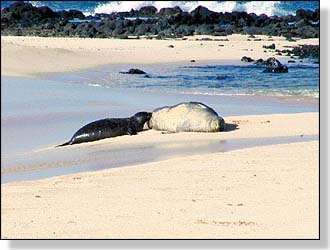Officials say Po’ipu won’t become a seal sanctuary A Kaua’i resident who said he counted five Hawaiian monk seals frolicking in the water and lolling on the sand at Po’ipu Beach Park recently is worried that what is now only
Officials say Po’ipu won’t become a seal sanctuary
A Kaua’i resident who said he counted five Hawaiian monk seals frolicking in the water and lolling on the sand at Po’ipu Beach Park recently is worried that what is now only a temporary beach closure for the seals’ sake may turn into a permanent ban on humans at the popular beach.
The Wailua man, who is a surfer, diver and fisherman, said he and others are tired of the inconvenience the beach closure, done for the safety of people and the mother seal raising a six-week-old pup, has meant for visitors and residents.
Most of the beach, and all of the popular swimming and snorkeling areas of the park, have been closed to the public since Aug. 10. Bright orange fencing around the separate coves at the park are expected to remain up until the mother abandons the pup, which is expected five to six weeks after birth. The pup was born July 22.
Spurred on by a California visitor’s recollection of how seals at a once-popular California beach turned that area into a sanctuary off limits to humans, the Kauaian has contacted elected officials, radio stations and wildlife experts, and may start a petition drive with a goal of getting the beach re-opened to the public.
“Basically, we want our beach back,” said the man, who asked to be anonymous.
He fears that if a colony of Hawaiian monk seals decides to call Po’ipu Beach Park home, the federal Endangered Species Act, which protects the seals, could lead to one of the state’s most popular beaches being converted to a no-humans sanctuary.
Such fears appear unfounded, though.
No such discussion has taken place at the National Marine Fisheries Service of the National Oceanic and Atmospheric Administration, said Delores Clark, NOAA spokeswoman.
Even if Po’ipu Beach Park were deemed worthy of being a sanctuary under the National Marine Sanctuaries Act, or even habitat critical to monk seal survival under the Endangered Species Act of 1973, that wouldn’t necessarily mean the beach or park would be permanently closed to the public – only when endangered species are present, Clark said.
And federal, state and county officials, working together, can do that now, as they have with the Kaua’i County park at Po’ipu, she said.
In order to declare Po’ipu Beach Park critical habitat under the endangered species act, it must be proven that the habitat is necessary for survival of the species and that the park is definitely critical to the seals’ survival. That would be hard to prove, she said.
To be declared a sanctuary under the National Marine Sanctuaries Act requires federal and state concurrence, she added.
Don Heacock, an aquatic biologist with the state Department of Land and Natural Resources, said that ordering a sanctuary at Po’ipu would require the unlikely scenario of the entire island being declared a sanctuary.
“That ain’t going to happen,” Heacock said.
But the Wailua resident who wants a seal-free beach noted that monk seals routinely return to the area they were born, and that this is the second consecutive summer for this monk seal mother to find Po’ipu the perfect place to plop, give birth and raise her pup.
He also questions whether or not “consultation provisions” of the endangered species act were considered when the decision was made to close the entire beach. And even though monk seals are solitary creatures except when breeding and raising their young, three other seals have been near the new seal family in Po’ipu recently.
Since so much is unknown about monk seal habits and behaviors, it is uncertain whether the mother monk seal at Po’ipu will decide to return again – ever.
“They’re likely to go wherever they want,” and once the fences, ropes and warning signs come down, “she might decide this isn’t a good spot any more and might go somewhere else,” said Heacock.
While good for regular beach users and visitors who wish to swim and snorkel at Po’ipu Beach, not having the monk seals around would be an educational opportunity lost, Heacock and others feel.
“Then you lose the opportunity to teach and talk to and educate thousands of people at a place like Po’ipu,” he said.
“We want the people and the seals to co-exist as much as possible,” said Dr. Jeff Walters, a biologist and marine mammal coordinator with DLNR. “We want to work with the (Kaua’i Monk Seal Watch Program) volunteers so that next year, if this happens, we can do it right and do it so that the people get to use the beach. I hope it works out that way.”
According to National Marine Fisheries Service biologists and Clark, the plan is to tag the pup and move it to another, less-crowded beach once its mother abandons it. The plan may be to move the pup onto the remote North Shore-area beach where another mother is nursing a newborn monk seal.
Since the Po’ipu pup turned six weeks old last Sunday, biologists are counting the days until the mother’s milk dries up and she abandons her offspring.
Staff Writer Paul C. Curtis can be reached at mailto:pcurtis@pulitzer.net or 245-3681 (ext. 224).


